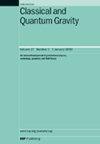( 2 + 1 ) ...
IF 3.6
3区 物理与天体物理
Q2 ASTRONOMY & ASTROPHYSICS
引用次数: 0
Abstract
We construct an effective cosmological spin-foam model for a dimensional spatially flat Universe, discretized on a cubical lattice, containing both space- and time-like regions. Our starting point is the recently proposed coherent state spin-foam model for (2+1) Lorentzian quantum gravity. The full amplitude is assumed to factorize into single vertex amplitudes with boundary data corresponding to Lorentzian 3-frusta. A stationary phase approximation is performed at each vertex individually, where the inverse square root of the Hessian determinant serves as a measure for the effective path integral. Additionally, a massive scalar field is coupled to the geometry, and we show that its mass renders the partition function convergent. For a single 3-frustum with time-like struts, we compute the expectation value of the bulk strut length and show that it generically agrees with the classical solutions and that it is a discontinuous function of the scalar field mass. Allowing the struts to be space-like introduces causality violations, which drive the expectation values away from the classical solutions due to the lack of an exponential suppression of these configurations. This is a direct consequence of the semi-classical amplitude only containing the real part of deficit angles, in contrast with the Lorentzian Regge action used in effective spin-foams. We give an outlook on how to evaluate the partition function on an extended discretization including a bulk spatial slice. This serves as a foundation for future investigations of physically interesting scenarios such as a quantum bounce or the viability of massive scalar field clocks. Our results demonstrate that the effective path integral in the causally regular sector serves as a viable quantum cosmology model, but that the agreement of expectation values with classical solutions is tightly bound to the path integral measure.( 2 + 1 ) ...
我们构建了一个有效的宇宙自旋泡沫模型,该模型在一个立方体晶格上离散,包含了空间和时间的区域。我们的出发点是最近提出的(2+1)洛伦兹量子引力的相干态自旋泡沫模型。假设全振幅分解为单顶点振幅,边界数据对应于洛伦兹3-frusta。在每个顶点分别执行一个固定相位近似,其中黑森行列式的倒数平方根作为有效路径积分的度量。此外,一个巨大的标量场耦合到几何,我们证明了它的质量使得配分函数收敛。对于具有时型支杆的单三锥体,计算了支杆体长度的期望值,结果与经典解基本一致,并且是标量场质量的不连续函数。允许struts是类空间的引入了因果关系违反,由于缺乏这些配置的指数抑制,这使得期望值远离了经典解决方案。这是半经典振幅只包含亏损角实部的直接结果,与有效自旋泡沫中使用的洛伦兹雷格作用相反。我们对如何在包含大块空间片的扩展离散化上求配分函数作了展望。这为未来研究量子弹跳或大规模标量场时钟的可行性等有趣的物理场景奠定了基础。我们的研究结果表明,因果正则扇区中的有效路径积分可以作为一个可行的量子宇宙学模型,但期望值与经典解的一致性与路径积分测度密切相关。
本文章由计算机程序翻译,如有差异,请以英文原文为准。
求助全文
约1分钟内获得全文
求助全文
来源期刊

Classical and Quantum Gravity
物理-天文与天体物理
CiteScore
7.00
自引率
8.60%
发文量
301
审稿时长
2-4 weeks
期刊介绍:
Classical and Quantum Gravity is an established journal for physicists, mathematicians and cosmologists in the fields of gravitation and the theory of spacetime. The journal is now the acknowledged world leader in classical relativity and all areas of quantum gravity.
 求助内容:
求助内容: 应助结果提醒方式:
应助结果提醒方式:


